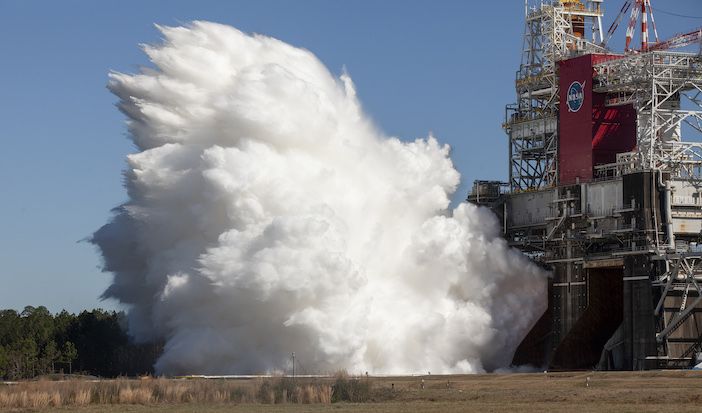The core stage of NASA’s Space Launch System, the rocket it will use for a manned Moon mission, has passed its hot fire test with its four RS-25 engines successfully igniting and burning for eight minutes and 19 seconds yesterday at NASA’s Stennis Space Center in Mississippi.
The successful test is a key milestone ahead of the NASA’s Artemis I mission, an uncrewed test flight and the first integrated flight of the Orion spacecraft and Space Launch System (SLS) heavy-lift rocket. Artemis I was planned to launch during November this year, but delays mean a new launch date is expected within the coming weeks.
The hot fire is the final in the eight-part Green Run test campaign to assess the core stage, which includes the liquid hydrogen and liquid oxygen tanks, four RS-25 engines, and the computers, electronics, and avionics of the rocket.
A hot fire test of the SLS core stage conducted in January was cut short to one minute because of limits to the test. Engineers wanted this second, longer hot fire test to provide data which will help verify the core stage’s design for flight.
NASA administrator Steve Jurczyk said, “The SLS is the most powerful rocket NASA has ever built and during today’s test the core stage of the rocket generated more than 1.6 million lbs of thrust within seven seconds.
“The SLS is an incredible feat of engineering and the only rocket capable of powering America’s next-generation missions that will place the first woman and the next man on the Moon.”
“Today’s successful hot fire test of the core stage for the SLS is an important milestone in NASA’s goal to return humans to the lunar surface – and beyond.”
The engines were fired for a little more than eight minutes during the second hot fire test, as they will during every Artemis launch to the Moon. The longer duration hot fire tested a variety of operational conditions, including moving the four engines in specific patterns to direct thrust and powering the engines up to 109% power, throttling down and back up, as they will during flight.
“This longer hot fire test provided the wealth of data we needed to ensure the SLS core stage can power every SLS rocket successfully,” said John Honeycutt, manager for the SLS Program at NASA’s Marshall Space Flight Center in Huntsville, Alabama. “During this test, the team conducted new operations with the core stage for the first time, repeated some critical operations, and recorded test data that will help us verify the core stage is ready for the first and future SLS flights for NASA’s Artemis program.”
The two propellant tanks in the SLS core stage collectively hold more than 733,000 gallons of supercold liquid hydrogen and liquid oxygen to help fuel the RS-25 engines at the bottom of the stage.
Test teams at Stennis have supervised a network of 114 tanker trucks and six propellant barges that provided liquid propellant through the B-2 Test Stand to the core stage. Test teams also delivered operational electrical power, supplied more than 330,000 gallons of water per minute to the stand’s flame deflector, and monitored structural interfaces of both the hardware and the stand.
Boeing is the prime contractor for the core stage and Aerojet Rocketdyne is the prime contractor for the RS-25 engines.
Next, the core stage for SLS will be refurbished, then shipped to NASA’s Kennedy Space Center in Florida, where it will be assembled with the solid rocket boosters and other parts of the rocket as well as the Orion in preparation for the Artemis I launch.





